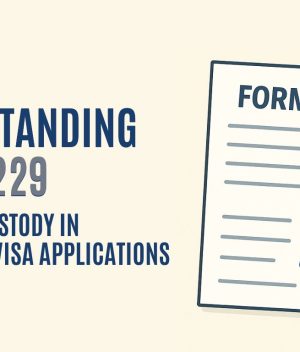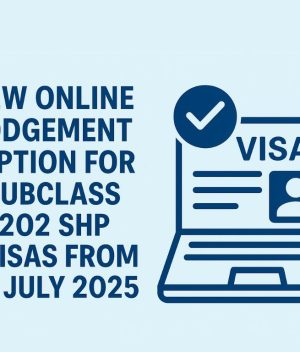What to Do if Your Protection Visa is Refused? Step by Step Guide

A protection visa refusal can be overwhelming and stressful, especially when your future depends on it. This is where protection visa appeals become so important.
However, it’s important to know that you still have options to challenge the decision.
With the right legal guidance, you can take steps to overturn the refusal and work towards securing your protection visa.
At Emigrate Lawyers, we have extensive experience in helping clients navigate the complex process of appealing protection visa refusals.
In this detailed guide, we explain the steps you need to take after a refusal and how we can help you build a strong case for your appeal.
1. Understanding Your Protection Visa Refusal
The first and most crucial step after receiving a protection visa refusal is to carefully read and understand your refusal letter.
Every protection visa refusal is different, so it’s important to pay attention to the specific details outlined in the letter.
Here’s what to look for:
✅Right to Appeal: Does the refusal letter state that you have the right to appeal the decision? Not all refusals can be appealed, so it’s essential to confirm whether this option is available to you.
✅Timeframe to Lodge an Appeal: If you have the right to appeal, the refusal letter will specify the deadline for lodging your appeal. This deadline is very strict and cannot be extended, so you must act quickly.
✅Appeal Body: Most onshore protection visa appeals are directed to the Administrative Review Tribunal (ART). The refusal letter will provide details on where and how to lodge your appeal.
Understanding these details will help you take the right steps within the required timeframe.
If you’re unsure about any part of your refusal letter, seeking legal advice immediately is highly recommended.
2. What Does the ART Do?
The Administrative Review Tribunal (ART) is an independent body that reviews decisions made by the Department of Home Affairs (DHA).
When you lodge an appeal, the ART will carefully review your case to determine whether the refusal decision was fair and reasonable.
The ART considers several factors during the review process, including:
- The evidence you provide to support your claims.
- Whether the DHA followed the correct legal processes.
- Any new information that may strengthen your case.
The ART hearing is your opportunity to present your case and demonstrate why the refusal decision was incorrect.
However, preparing for this hearing requires a strategic approach and thorough preparation.
3. Steps to Take After a Protection Visa Refusal
If your protection visa application has been refused, it’s important to act quickly and follow these steps:
a) Seek Legal Advice
The protection visa appeals process can be complicated, and mistakes can be costly.
Seeking legal advice from an experienced migration lawyer will ensure that your case is handled professionally and that your appeal is submitted correctly and on time.
b) File Your Appeal
Lodge your appeal with the ART before the deadline specified in your refusal letter.
The system does not accept late submissions, so file your appeal as soon as possible.
c) Prepare Your Case
Building a strong case is key to the success of your appeal. This involves:
- Carefully reviewing the reasons for your visa refusal.
- Gathering new evidence to support your claims.
- Preparing a detailed submission that addresses the DHA’s reasons for refusal and explains why the decision was incorrect.
d) Get Ready for the Hearing
The ART hearing is your chance to present your case and provide additional information.
You must be well-prepared to answer questions and respond to any concerns raised by the ART member reviewing your case.
4. What to Expect During the ART Hearing
The ART hearing is an important part of the appeals process. Here’s what you need to know about how it works:
a) Notification of Hearing Details
The ART will notify you of the date, time, and location of your hearing.
Hearings are usually held at an ART office in your state capital, but they may also be conducted online via video conference.
b) Interpreter Services
If English is not your first language, you can request an interpreter to assist you during the hearing.
This service is provided to ensure that you can fully understand and participate in the hearing process.
c) Presenting Your Case
During the hearing, you will have the opportunity to:
- Explain your circumstances and the reasons you are seeking protection.
- Provide additional evidence to support your claims.
- Respond to questions from the ART member.
It’s important to present your case clearly and confidently.
This is where legal representation can make a significant difference, as your lawyer can help you prepare for the hearing and ensure that your arguments are presented effectively.
5. Building a Strong Case for Your Appeal
Appealing a protection visa refusal requires a well-prepared and strategic approach.
At Emigrate Lawyers, we use a comprehensive process to help our clients build strong cases for their appeals.
a) Reviewing the Refusal Letter
We start by thoroughly reviewing your refusal letter to identify the reasons for the DHA’s decision. This helps us identify the key issues to address in your appeal.
b) Gathering New Evidence
To strengthen your case, we gather new evidence that supports your claims. This may include:
- Witness statements.
- Medical reports.
- Detailed country research to demonstrate the risks you face in your home country.
c) Preparing a Legal Submission
We prepare a detailed legal submission that outlines your arguments and addresses the reasons for your visa refusal.
This submission explains why the DHA made an incorrect decision and why you should receive your protection visa.
This submission is usually 20-60 pages long.
d) Mock Hearings and Preparation
To help you feel confident and prepared for the ART hearing, we conduct mock hearings and guide how to answer questions effectively.
We also provide psychological support to ensure that you are ready for the challenges of the hearing process.
6. What Happens After the Hearing?
Once the ART hearing is complete, the tribunal will make a decision. There are two possible outcomes:
a) Remit the Decision
If the ART remits the decision, it means they do not agree with the DHA’s refusal.
Your case will be sent back to the DHA for further assessment, and your protection visa is likely to be approved.
b) Affirm the Decision
If the ART affirms the decision, it means they agree with the DHA’s refusal.
In this case, your only option may be to appeal to the Federal Circuit Court, but this is only possible if there is a legal error in the ART’s decision.
7. Why Experience Matters in Protection Visa Appeals
Appealing a protection visa refusal is a complex legal process that requires expertise and experience.
Choosing the right migration lawyer can make a significant difference to the outcome of your case.
At Emigrate Lawyers, we have years of experience handling protection visa appeals and a proven track record of success.
Our team navigates the legal system and builds strong cases to give clients the best chance of success.
8. How Emigrate Lawyers Can Help
At Emigrate Lawyers, we provide comprehensive legal support for protection visa appeals.
Our services include:
✅Reviewing your refusal letter and identifying key issues.
✅Preparing a strong legal submission supported by evidence and research.
✅Helping you prepare for the ART hearing through mock sessions and guidance.
✅ Representing you at the hearing and making oral submissions on your behalf.
9. Contact Emigrate Lawyers Today
If authorities refuse your protection visa application, don’t lose hope.
Let Emigrate Lawyers help you fight for your visa and work towards a successful outcome.
Related Insight –





